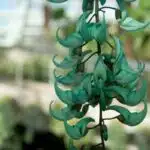We all want plants that are low maintenance and easy to care for, and the best part is when they’re beautiful too! Jade plants, also known as Crassula ovata, fit the bill perfectly; they are hardy, attractive and can even bring you luck. If you’re looking to add a little green to your indoor space, then jade plants could be just the ticket. But in order to get the most out of these little gems, it’s important to know how to care for them properly. In this article we’ll be taking a deep dive into what it takes to keep your jade plant thriving indoors.
For centuries, these succulents have been valued as a symbol of good fortune and prosperity- so much so that it’s said “a jade plant in the home is worth a thousand pieces of gold”. The Chinese refer to them as “The Money Plant” or “The Friendship Tree”, where gifting one is seen as a gesture of good wishes for years of health and happiness. It’s no wonder why these plants have become such popular houseplants over the years!
Jade plants may look delicate but they’re actually quite sturdy and resilient – perfect for those with busy lifestyles or who don’t have green thumbs. With some basic knowledge about how to care for them properly, you’ll be able to ensure your jade plant will thrive in its new home indoors. Ready? Let’s get started on our journey together!
1.Choosing A Jade Plant
It’s no secret that jade plants are incredibly popular houseplants. But what many people don’t realize is that choosing the right jade plant for indoor growth can be a tricky affair. With so many varieties to choose from, it can be hard to know where to start! So how do you pick the perfect jade plant for your home? Let’s take a look.
First and foremost, you’ll want to consider the size of the plant when selecting your jade. There are several different sizes of jade plants, ranging from tiny desk-sized specimens up to large potted specimens that can reach heights of two feet or more. Depending on how much space you have available and what kind of look you’re going for, you’ll want to select the size that works best for your needs.
You’ll also want to pay attention to the type of leaf when picking out a jade plant. Some varieties have thick, fleshy leaves while others have thin, waxy ones. The type of leaf will determine how much water and sunlight your plant needs in order to thrive indoors, so be sure to choose one that fits with your lifestyle and environment.
Now that you’ve got the basics down, it’s time to consider where you plan on placing your new jade plant and what kind of care it will need in order for it to flourish.
2.Location Considerations
Time stands still – if you want your jade plant to thrive in your home, the right location is key! With a few simple considerations, you can make sure your jade is placed perfectly.
First, it’s important to remember that jade plants prefer bright indirect light – too much direct sun will scorch the leaves and cause them to dry out. Aim for a spot near a window with a curtain or blind to filter some of the sunlight. If you don’t get enough natural light for your jade, you can supplement with grow lights or fluorescent bulbs.
The temperature of your home also matters – jades like warm temperatures between 65-75 degrees Fahrenheit. Cold drafts and chilly temperatures can cause leaves to drop off and affect growth. Finally, make sure there’s enough space around the pot for air circulation and avoid overcrowding other plants nearby to keep your jade healthy and happy!
Watering needs are just as important for keeping your jade plant in top condition…
3.Watering Needs
Watering your jade plant is an important part of taking care of it. It’s best to water the plant when the top inch of soil feels dry. This ensures that you don’t overwater it, as jade plants are prone to root rot if they’re left sitting in wet soil. When you do water, make sure it’s thoroughly soaked throughout the entire soil, and then allow the excess water to drain away completely.
It’s also important not to let your jade plant sit in standing water for too long; if this happens, move it to a pot with better drainage or add more perlite or sand to improve drainage. For best results, use room-temperature or lukewarm water as cold water can shock the roots.
It can be tricky finding the right balance with watering a jade plant, but if you stick to these guidelines and observe how your particular plant responds, you should have success with keeping it healthy and thriving indoors. Moving on from here, we’ll look at fertilizer requirements for your jade plant.
4.Fertilizer Requirements
Fertilizer requirements are important for the health and growth of jade plants. When it comes to fertilizing, less is more. An all-purpose liquid fertilizer diluted to half strength should be applied once a month during spring and summer. It’s best to avoid fertilizing in the fall and winter months when the plant is in its dormant state.
For the healthiest growth, fertilize with a balanced fertilizer such as a 10-10-10 formulation, but an organic fertilizer or fish emulsion can also be used if desired. Avoid high nitrogen fertilizers as they will encourage leafy growth at the expense of flowers, which jade plants seldom produce indoors anyway.
If you’re unsure what type of fertilizer is best for your plant, consult your local garden center or nursery professional for advice. Remember that too much fertilizer can cause damage to your jade plant so err on the side of caution. With correct fertilizer use, your jade plant should remain healthy and look its best! Now let’s take a look at light requirements for indoor growing of jade plants.
5.Light Requirements
The theory that jade plants require a certain level of light in order to thrive is undoubtedly true. After all, many plants need the right amount of sunlight to live and grow. So, what kind of light do jade plants need?
When it comes to light requirements for growing jade plants indoors, there are several factors to consider. First, the plant needs bright but indirect sunlight or artificial light. If it doesn’t receive enough light, its leaves will become pale and it won’t be able to photosynthesize properly. On the other hand, if it gets too much direct sunlight, the leaves can get scorched and damaged. To ensure that your jade plant has enough light, place it near an east-facing window or use a grow lamp for about eight hours per day.
In addition to providing adequate lighting for your jade plant, you should also make sure that the temperature around it is maintained at a comfortable level as well. Temperatures between 60°F and 80°F (15°C – 27°C) are ideal for keeping your jade plant healthy, so make sure you provide adequate heating and cooling when necessary.
6.Temperature Needs
It is important to understand that temperatures for jade plants should be between 65 and 80 degrees Fahrenheit, according to the University of California’s Department of Agriculture and Natural Resources. Keeping the plant in an environment that maintains this temperature range is essential for its health.
When it comes to temperatures, significant changes can be damaging. A drastic decrease or increase can cause your jade plant to become stressed and even die. Additionally, sudden changes in temperature can also lead to yellowing foliage and leaf drop. To protect your jade plant from these issues, try not to move it around too much as this could cause a shock.
To ensure your jade plant stays healthy, make sure you monitor the temperatures in its environment and keep them consistent. This will help maintain its growth and prevent any potential damage from occurring due to extreme temperatures. Now let’s discuss humidity requirements for keeping a healthy jade plant indoors...
7.Humidity Requirements
Humidity requirements are an important factor when it comes to caring for a jade plant indoors. Without proper humidity, the leaves may start to curl and brown, and the plant may struggle with growth. To increase humidity around your jade plant, you can place it in a tray of water and gravel, mist it frequently, or use a humidifier nearby.
Be careful not to raise the humidity levels too high, as this can lead to diseases like root rot or fungal infections. If you notice any of these signs on your jade plants, reduce the humidity levels right away. Also, do not keep your jade plant near air conditioning vents or radiators as this can cause it to dry out too quickly.
By following these guidelines, you’ll be able to keep your jade plants healthy and thriving indoors. As long as they have enough moisture and good airflow, they should be able to grow happily in their new home. With that said, let’s move on to the next step: pruning and trimming!
8.Pruning And Trimming
The classic jade plant is a symbol of luck and prosperity in many cultures and has been a popular houseplant for centuries. With a few simple tips, you can easily keep yours looking its best. Pruning and trimming are two essential steps when caring for jade plants.
When it comes to pruning, timing is everything. If you want your jade plant to stay compact and bushy, you should prune it regularly throughout the year. For best results, prune away any dead or dying leaves, branches, or stems as soon as you see them. You can also use pruning shears to shape your jade plant into a more attractive shape when needed.
Trimming is also important for keeping your jade plant healthy and happy. When trimming your jade plant, be sure to use sharp scissors or garden clippers so that you don’t damage the stems or leaves of your beloved houseplant. To promote healthy new growth, make sure to remove any yellowed foliage from time to time; this will help encourage new buds and blooms!
In addition to these two simple steps, providing adequate light and water are key elements in maintaining a lush jade plant. Now that we’ve covered the basics of pruning and trimming – it’s time to move onto propagating from cuttings!
9.Propagating From Cuttings
It is often theorized that propagating from cuttings is one of the most effective ways to care for jade plants. To investigate this theory, let’s look at how propagating from cuttings works and why it is beneficial for growing jade plants indoors.
Propagation from cuttings involves taking a stem cutting from a mature jade plant and planting it in soil. The cutting should be taken when the plant is actively growing and have several leaves attached. This helps ensure the cutting will thrive once planted. Once planted, the cutting should be kept in moist soil with bright, indirect light and warm temperatures in order to encourage root growth. It typically takes four to six weeks for roots to form on the cutting before it can be moved into its own pot or container.
The benefit of propagating from cuttings is that you can grow more jade plants relatively quickly and cheaply compared to other methods. This method also allows you to clone existing plants so they have identical characteristics, making them easier to care for since you know what to expect from them. By following these steps, you can use propagation from cuttings as an effective way to care for your jade plant indoors. And with that knowledge, transitioning into repotting and containers becomes easier than ever!
10.Repotting And Containers
It’s almost ironic that the last steps of caring for a jade plant include repotting and containers – after all, when taking care of any living thing, the container is often where it all begins. The tenth step in our guide to cultivating jade plants indoors is all about these two aspects, which are essential to ensuring your houseplant thrives.
When it comes to repotting, timing is key. If you can’t remember when you last re-potted your jade plant, it’s probably time to give them a new home! Choose a pot that has plenty of drainage holes and use a soil specifically designed for cacti and succulents. Make sure to add some organic matter like compost or perlite too. Once planted, your jade should be watered thoroughly but not over-watered; allow the soil to dry out between watering sessions.
Containers are also important when it comes to caring for your precious jade plant! Pick one with plenty of room for growth and make sure it’s made from a sturdy material; terracotta pots are best as they allow air circulation through the sides – essential for helping excess water escape quickly.
Armed with this knowledge, you’re now ready to tackle any common problems that might arise during your journey with jade!
11.Common Problems
Although it might seem that caring for a jade plant indoors could be complicated, it is actually quite easy when you understand the basics. Repotting and containers are important steps in ensuring your jade plant is healthy, and understanding common problems is just as essential.
Common problems may arise with jade plants, such as leaves dropping off due to inadequate water or light levels. It may also not grow vigorously if the soil doesn’t drain quickly enough or if the container isn’t big enough. Fortunately, these issues can be addressed by increasing light exposure or adjusting the water and soil drainage.
If you notice any pests on your jade plant, such as mealybugs or aphids, it’s best to take swift action to eradicate them. Insecticides can be used but they should only be used as a last resort while being sure to follow all safety instructions on application. With proper care and attention, you can ensure your jade plant remains healthy and beautiful for years to come. Now let’s look at common pests and diseases that can affect jade plants…
12.Common Pests And Diseases
Coincidentally, pests and diseases are two of the most common problems that jade plant owners can face. Pests like mealybugs, aphids and spider mites can feed on the leaves or stem of your jade plants, causing them to become distorted or discolored. Meanwhile, diseases such as root rot, leaf spot and rust can also cause damage to your jade plants if left untreated.
Understanding how to identify pests and diseases is key in preventing them from affecting your jade plants. Mealybugs are small white insects that feed on the leaves and stems of plants while aphids are small green bugs that suck the sap out of a plant’s leaves. Spider mites are tiny red dots that spin webs over the leaves while root rot is caused by overwatering which leads to rotting roots. Leaf spots are caused by bacteria that cause spots on leaves while rust is an orange-colored fungus that can spread quickly across a plant’s foliage.
The best way to protect your jade plants from pests and diseases is to keep an eye out for any signs of infestations or disease development and take appropriate action quickly. Regularly inspecting the foliage for any changes in color or texture and addressing any issues immediately will help prevent further damage from occurring.
13.Tips For Growing Jade Indoors
One would think that caring for a jade plant indoors is a breeze, yet ironically, it’s one of the most difficult plants to maintain indoors. However, with the right tips and techniques, growing a jade plant indoors can be achieved! This section of the guide talks about how to care for your jade plants indoors.
When growing a jade plant indoors, you will need to make sure the environment is optimal for their growth. Make sure to provide plenty of sunlight and keep them in an area with high humidity levels. You should also water them regularly but don’t overwater them. Additionally, they need regular pruning and fertilizing.
With the proper maintenance and attention, your jade plants will thrive! All you have to do is find the perfect spot for them in your home and take care of them properly. With that said, let’s move on to discussing harvesting and uses for this beautiful indoor plant.
14.Harvesting And Uses
Perhaps harvesting jade plants is like the harvesting of all things precious in life – it requires patience and care, and a bit of luck. As one might expect, most of the work is done before the actual harvest, with careful pruning and attention to the environment. But if you have done your job correctly, then reaping the rewards of your efforts can be immensely satisfying.
A jade plant’s use depends largely on who is using it. For some, it may simply be a matter of having a beautiful houseplant to admire; for others, it might be an herbal remedy or a lucky charm. In either case, cutting off a branch or two from time to time will not harm the plant if done judiciously: just make sure that you leave enough foliage for photosynthesis.
Whatever your reason for wanting to harvest your jade plant, keep in mind that its health should always come first. If there is any doubt about whether or not to proceed with a cut, err on the side of caution and wait until conditions are more favorable – after all, this plant has been with you through thick and thin! With patience and diligence, you’ll be well on your way to enjoying the fruits (or leaves!) of your labor.
15.Troubleshooting And Advice
As luck would have it, troubleshooting and advice are the last steps in caring for jade plants. It’s important to remember that while they’re relatively easy to care for, jade plants can still be affected by a range of problems. In this section, we’ll explore some common issues and provide advice on how to keep your plant healthy.
Firstly, it’s important to check your plant regularly for signs of pests or disease. If you notice any discoloration or spots on the leaves, inspect them closely and take action if necessary. You may need to use an insecticide or fungicide depending on the type of pest or disease your plant is suffering from. Secondly, make sure that you don’t over-water your jade plant as this can cause root rot which can be fatal. Always check the soil before watering and water only when it’s dry. Lastly, it’s essential to ensure that you provide adequate light for your jade plant; however, too much direct sunlight can also cause damage so make sure that you place your plant in a spot with indirect light instead.
In short, caring for a jade plant requires regular inspections for pests and diseases as well as ensuring that the soil is not over-watered and that there is adequate but not excessive light exposure. With these tips in mind, you should have no problem keeping your jade plant healthy and happy!
Frequently Asked Questions
How Long Does A Jade Plant Take To Mature?
Jade plants are a great addition to any indoor garden – not only are they low maintenance, but they also look beautiful. But just like any other plant, it takes time for them to reach full maturity. So the question remains: how long does it take for a jade plant to mature?
Time is an abstract concept, so it’s hard to put an exact number on it – however, like most houseplants, you can expect your jade plant to take anywhere from two to three years before reaching its full potential. This isn’t an overnight process; rather, it’s a gradual one that will require patience and care. As the old adage goes: good things come to those who wait!
So if you’re looking for a long-term commitment with your jade plant, be prepared for the journey – you won’t be disappointed with the results! With proper care and attention, your jade plant will soon become a healthy and vibrant part of your home.
How Often Should I Water My Jade Plant?
When it comes to caring for a jade plant, one of the most important details to consider is how often you should water it. It’s all too easy to overwater, leading to root rot and other issues, or underwater, resulting in wilting and leaf drop. To ensure your jade plant thrives, understanding the watering needs of these plants is essential.
First, you’ll want to look at the type of soil they’re planted in. Jade plants prefer well-draining soil that won’t stay soggy for long periods of time. Succulent potting mixes are a great option because they contain perlite or pumice, which help promote drainage and aeration in the soil. During the growing season (spring through fall), you should water your jade plant every 7-10 days when the top inch or two of soil is dry. Overwintering jades need less water; so wait until the top two inches of soil have dried out before watering again.
If you’ve been following these guidelines and your jade plant still looks wilted or has yellowing leaves, check the roots by carefully removing it from its pot and examining them for signs of rot (browning tips). If this is present, repot with fresh soil as soon as possible and reduce watering frequency until your jade recovers. With just a few extra steps, you can keep your jade healthy and happy!
How Much Light Does A Jade Plant Need?
Caring for a jade plant is like caring for a child, it requires attention and love. Just like a child needs the right amount of sunlight to grow healthy, so does a jade plant. It’s important to know how much light your jade plant needs in order to keep it thriving indoors.
When considering how much light your jade plant needs, think about where you would put it if you were outdoors. Jade plants prefer bright, indirect sunlight, such as what they’d get if they were near an east- or west-facing window. If the sun is too direct, the leaves can get sunburned, so be sure to keep them out of direct sunlight and opt for indirect light instead.
If you’re having trouble finding an area with enough indirect light for your jade plant, consider investing in some grow lights. Grow lights come in all shapes and sizes and can help supplement any lack of natural light your home might have. With proper lighting, your jade plant will be able to flourish just as well indoors as it would outdoors!
Is It Difficult To Propagate From Jade Plant Cuttings?
Growing jade plants can be a rewarding experience, but the thought of propagating them from cuttings can be daunting. It’s almost like reaching into the unknown – a wild adventure that could lead to success or failure. With just one wrong move, it’s easy to lose hope of ever expanding your jade plant collection. However, with the right technique and knowledge, propagating a jade plant from cuttings isn’t as difficult as it seems!
Propagating a jade plant from cuttings is all about timing and technique. First, you’ll need to select healthy stems on your existing jade plant that are firm, plump and bright green in color. Make sure that each cutting has at least two sets of leaves before snipping off with sharp scissors or pruning shears. Once you’ve made your cuttings, put them aside in an area with indirect sunlight for 1-2 days so they can heal over any wounds caused by cutting.
Finally, once the cuttings have healed over it’s time to transfer them into soils or potting mix for further growth and development. Make sure to place your cuttings in an area with bright light for optimal growth conditions. Watering your new cuttings every few days will help keep their soil moist while allowing their roots to grow strong and healthy over time. With patience and proper care, you should see new growth within weeks!
Can Jade Plants Thrive In Low Humidity Environments?
Propagating jade plants is a great way to get more of these vibrant and resilient plants. But, if you’re caring for your jade plant indoors, can it thrive in low humidity environments? The answer is yes!
Jade plants are succulents that are incredibly hardy and able to withstand a variety of conditions. This includes low-humidity environments. In fact, they actually prefer a dry environment because too much moisture can lead to root rot. That said, some humidity is beneficial, but they don’t need as high of levels as other houseplants.
If you have a jade plant in a low-humidity setting, you’ll want to make sure there’s good air flow around the plant and water it deeply but infrequently. Also check for signs of distress like wilting or discoloration on the leaves which could be an indication that it’s not getting enough moisture from its environment. With proper care, your jade plant can thrive even with lower levels of humidity.
Conclusion
Jade plants, also known as money trees, are resilient and beautiful plants that make a great addition to any home. With the right care and attention, your jade plant can give you years of joy with its glossy leaves and delicate flowers. Caring for a jade plant is like tending to a garden. You need to give it the proper amount of water, light, and fertilizer in order to ensure it grows strong and healthy. If you’re willing to put in the effort, your jade plant will be a hardy companion that can bring life and beauty into your home.
Caring for a jade plant is really quite simple. With just a few minutes of care each week, your jade plant will thrive indoors with little effort on your part. Think of it like cooking dinner: you put in the right ingredients and follow directions carefully, and eventually you’ll have something delicious! Give your jade plant some love, patience, and consistency and you’ll be rewarded with vibrant growth that looks like living art in your home or office.
To sum up, caring for jade plants is rewarding when done correctly; they may not require much work from you but they do need consistent attention and care. Like any living thing in nature, these plants will blossom if treated with kindness – treat them like an old friend that visits every day! With just a bit of love from you your jade plant will be sure to grow into something beautiful that reminds you how precious life can be.





























